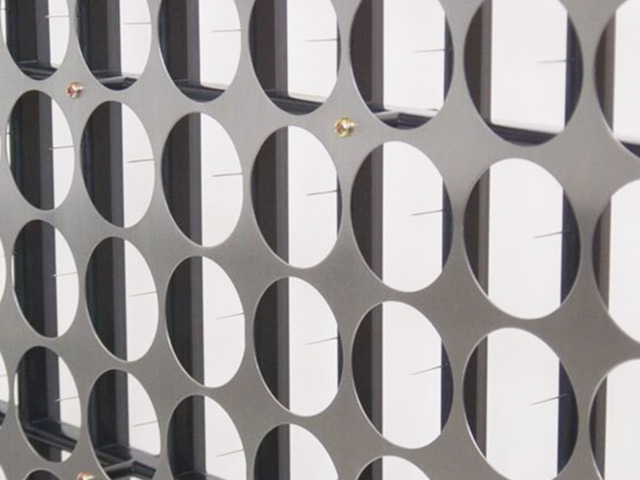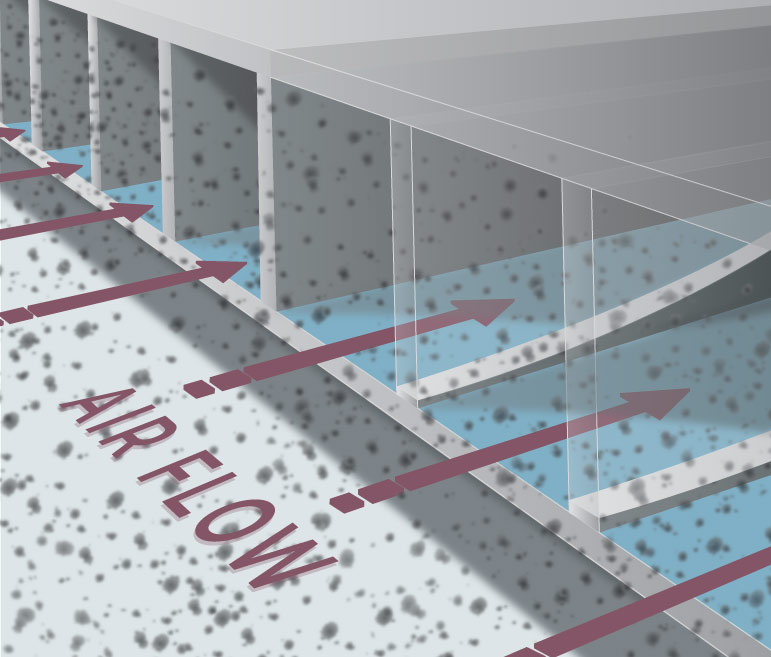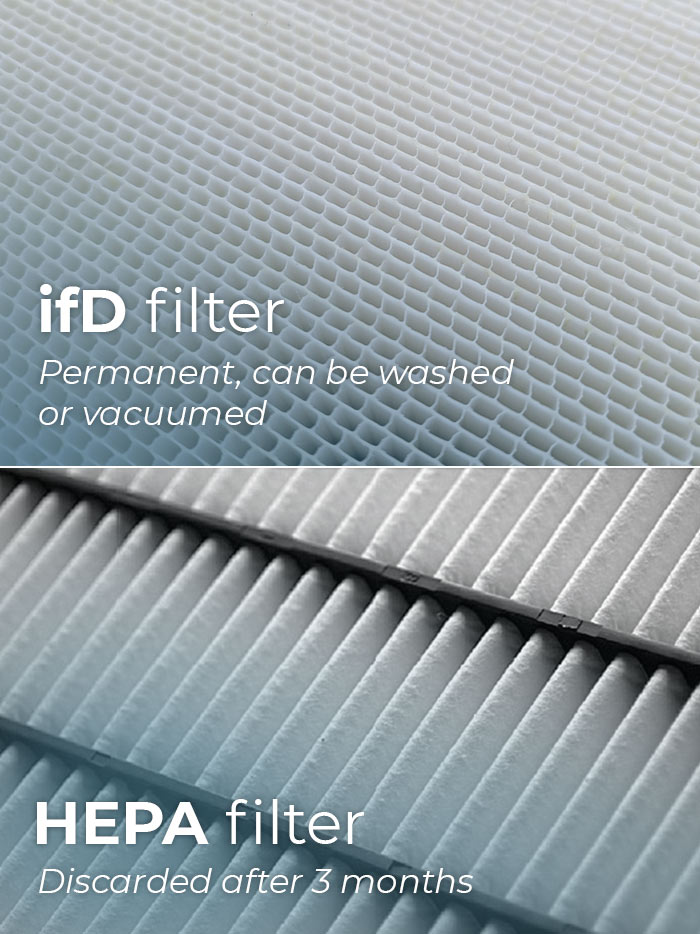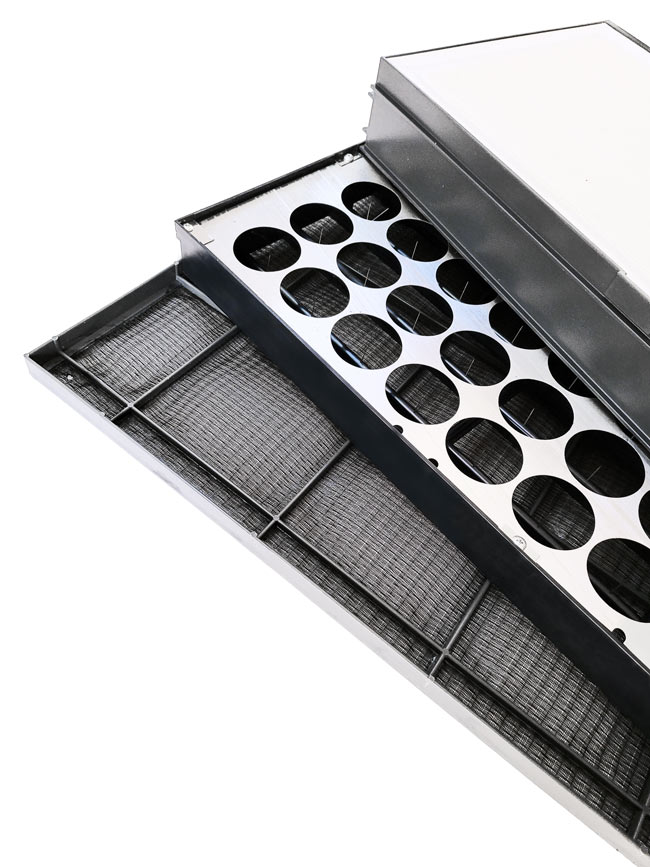When ifD licensee, Trane Technogies Inc., launched their Clean Effects whole-house air purifier containing ifD they described it as follows, “Once in a great while a new technology comes along that revolutionizes an entire industry. For the air purification industry, that technology is here. It’s light-years ahead of anything else out there“. This statement remains true today, as ifD continues to be the world’s most advanced air purification technology.
“The first time we tested ifD we thought there was something wrong with our instruments because we were detecting almost no particles. After double checking we realized the instruments were fine—the “problem” was that the ifD filter was so efficient there was almost nothing to detect.” —Al Vatine President, LMS Laboratories
ifD stands for “Intense field dielectric”, which describes the mechanism by which an ifD filter is able to remove the tiniest sub-micron particles without the use of a high-pressure-drop fiber matrix, as found in HEPA filters.

ifD particle-charging unit — used in certain applications
In an ifD system particles in a propelled airstream are electrically charged before passing into hollow, polymer flutes. These flutes are built up in layers, or rows, to form a ‘honeycomb’ shaped filter, and each row contains thin electrode sheets that generate intense electrical fields within the flutes.

The polymer flute materials used in an ifD filter are ‘dielectric’, which means they have ‘the property of transmitting electric force without ‘conduction’. This dielectric property prevents current flowing between the electrodes and inhibiting the creation of the intense field — as occurs in conventional electronic air purifiers and electrostatic precipitators. Upon entering the intense field the charged particles are immediately attracted to the oppositely charged surfaces of the flutes and remain there until the filter is cleaned. The propelled air then leaves the filter clean, fresh, and free from even the tiniest of pollutant particles.

While simple in principle, Darwin has invested years in identifying how the ifD technology works optimally in a wide range of applications. Darwin technicians are therefore able to work with licensees to help them meet design briefs that will optimize ifD for any application based on the amount of space available, targeted efficiency levels, preferred materials, and budgetary parameters.

ifD particle-charging unit — used in certain applications
Even though HEPA filters have been around a lot longer, and as a result are more widely known, they pale in comparison with ifD. ifD filters can produce BETTER THAN HEPA levels of efficiency while producing far less pressure drop (air resistance). This means ifD filters can often provide high efficiency filtration solutions in application areas where HEPA would be unsuited — such as in air conditioning systems. Also, IfD filters can be easily cleaned and reused repeatedly, which enables users to avoid the high cost of replacement HEPA filters.


| ifD | HEPA | |
|---|---|---|
| Efficiency (particle capture 0.3 microns) | Excellent + Up to 99.99% | Excellent 99.97% |
| Pressure Drop (resistance) | Excellent 10-50 pascals | Poor 150-350 pascals |
| Energy Cost | Excellent Air easily passes through the open honeycomb structure within ifD filters | Poor Significantly more energy is needed to draw the air through the filter, due to high air resistance & pressure drop |
| Maintenance Cost | Excellent Filter requires occasional cleaning, which takes minutes. | Poor Requires frequent filter replacement & disposal. |
| Service Life | Excellent Permanent: Never needs replacing. | Poor Loads quickly unless configured with substantial pre-filtration. |
| Noise | Excellent Low pressure drop = low noise | Poor High pressure drop = high noise |

Creating an electrical charge in airborne particles is an essential preliminary step in the ifD air purification process. ifD filters owe their exceptional efficiency to the creation of a powerful electrical attraction between airborne particles and the interior surfaces of the filter. To achieve this, the particles are given a positive or negative charge before they enter the filter. This pre-charge assures they will have the strongest possible attraction to any surface that has an opposite charge.
The ifD filter is a honeycomb of hollow “flutes” or air channels, whose “floors” and “ceilings” are alternately charged or grounded via embedded electrodes to create a powerful, polarized electrical field inside the flutes. When the pre-charged particles enter the flutes, they are pulled to the oppositely charged surfaces, where they are trapped.
Without the pre-charging step, particles would be much more likely to pass through the filter without being captured, especially at higher airspeeds.
Excellent efficiencies are currently being achieved with filters as thin as one inch. Even thinner filters are currently being developed and tested.
Pressure drop is low with ifD filters because there is no need to force air through a matrix of small air passages, as traditional media filters do. Instead, ifD uses electronic attraction to “pluck” particles from the air as it flows freely through the smooth polymer flutes of the filter’s open “honeycomb” structure.
The high-strength electrical fields within each of the filter flutes are extremely effective at capturing and trapping airborne particles. The physics of this is entirely different from the mechanical process of traditional, high-mass media filters.
The important difference between ifD and traditional electronic air cleaners (EACs—sometimes also referred to as electrostatic precipitators or ESPs) is that the charged surfaces used to attract particles in EACs are not dielectric. While the two systems share the procedure of pre-charging airborne particles and a collection system of polarized fields to trap them, only ifD’s system of dielectric-encased electrodes permit creation of the super-strong electrical fields necessary for highest-efficiency performance.
A traditional EAC utilizes an array of thin metal plates placed parallel to the direction of the airflow. Their thinness and wide spacing present very little resistance to airflow. Each individual plate is powered or grounded to have an opposite electrical charge to the adjacent plate, thus creating an electrical field between the plates. Charged, airborne particles are attracted to plates with the opposite charge. When particles make contact with the plates, they are trapped and held.
Lower efficiency is one limitation of such EAC filters. This is a result of the relatively wide spacing of the metal plates. Danger of electrical arcing between them mandates ample separation. This limits the field strength that can be generated and thus the ability of the plates to attract particles from the air.
Higher maintenance is another characteristic of EACs. Accumulation of dust on the plate surfaces encourages electrical arcing and may result in audible pops and crackles, as well as loss of field strength. Regular and often time-consuming cleaning is necessary to counteract these problems.
ifD filters, by contrast, have no bare electrical components. The electrode surfaces are encased in a special dielectric (non-conductive) material, which prevents arcing between the electrodes. The electrodes can therefore be placed very close together—the distance can be as little as a single millimeter—which results in the creation of extremely high electrical field strength within the air passages between the electrodes. This, in turn, makes it possible to achieve an exceptionally high rate of particle capture without noise or electrical breakdown.
Because ifD filters are sealed, they can be safely removed and cleaned with a vacuum or even washed with water. It takes only a few minutes to fully clean an ifD filter and restore it to maximum efficiency.
An electret filter incorporates both mechanical fiber matrix particle removal and electrostatic particle attraction. ifD is 100% electrostatic.
Electret filters are made of fibers or fine strips that are given an electrical charge on one side during the manufacturing process. This electrical charge will remain on the surface of the fiber for some time. When these fibers are woven and matted into a filter, the result is a media matrix that contains many tiny electrical fields between its fibers. Most airborne particles naturally have some small amount of electrical charge, or polarity, either positive or negative. When they pass into an electret filter, the opposite charge on the surface of a filter fiber attracts the particle and increases the likelihood of entrapment in the matrix.
Over time electret filters lose their charge and thus revert to being purely mechanical filters. How long this takes is a function of how quickly the filter is loaded with particles and, very importantly, the nature of the particles themselves. Cigarette smoke particles, for example, can wipe out the charge of some electret filters almost immediately, causing the filter’s initial efficiency to collapse. However, continued loading of particles into an electrostatically “dead” filter will eventually cause filtration efficiency to rise again as the air spaces fill up or become constricted. Yet in the interim, that is, after the loss of the filter’s electrostatic properties but before effective levels of mechanical efficiency are reached through particle loading, there may be a period of time when the filter operates well below its initial or stated efficiency.
By contrast, ifD filters are continuously powered with electricity and will, with periodic cleaning, maintain their field strength and their effectiveness. Side-by-side tests have shown that even without cleaning, an ifD filter can continue to operate at high efficiencies under many conditions, including heavy exposure to cigarette smoke, long after the efficiency of a typical electret filter has collapsed.
A properly selected and maintained ifD filter should be highly effective at capturing and trapping such microbes. ifD filters can be configured to capture up to 99.99% of airborne particles that are 0.3 microns in diameter, which is smaller than virtually all viruses, bacteria and spores and has been found to be more difficult to capture than particles smaller in size.
ifD filters are not intended for odor control. Since the organic compounds in the air that are the source of most odors are not particles, but volatile gases, they will pass through the ifD filter unaffected by particle charging and intense electrical fields. While in some cases capturing particles may help reduce odor, true VOC (volatile organic compounds) removal will require the use of some additional technology in conjunction with ifD. (The need for supplementary odor control is true of traditional media filters, as well.)
Tests have shown that ifD filters can be designed to withstand extreme smoking conditions with next to no loss of efficiency. ifD filters have been subjected to cigarette smoke testing in accordance with standards created by the Japan Electrical Manufacturers Association (JEMA), which are among the most rigorous in the world. In these tests the smoke of as many as 720 cigarettes per square foot of filter area (the equivalent of several years’ worth of normal domestic exposure) produced almost no decrease in ifD filter efficiency.
Strictly speaking, current MERV test methodology is applicable only to media filters; however, it is possible to modify the test to produce a “MERV equivalent” rating for an ifD filter. MERV ratings are determined using a standardized test developed by the Association of Heating, Refrigeration and Air Conditioning Engineers (ASHRAE).
This test is designed to predict the long-term performance of a filter. However, it incorporates certain assumptions that apply to traditional media filter technology but not to advanced technologies such as ifD, or metal plate electronic air cleaners (EACs).
In particular, the test calls for a prescribed type of dust to be “loaded” onto the filter until the filter clogs to the point of reaching a certain pressure drop (resistance). The filter is then tested for its “after-loading” efficiency, which theoretically gives some idea of how it will perform in real-life conditions.
With an ifD or EAC filter it is not possible to reach the test-mandated high levels of pressure drop using ASHRAE dust, no matter how much is loaded into the air stream. Therefore the only way to get a meaningful rating for an ifD or EAC filter is to modify the standard test protocol.
One method is to load the filter with a prescribed amount of dust by weight, rather than by measuring changes in pressure drop. The amount of dust used should reasonably reflect several years’ worth of loading under typical conditions.
NOTE: In some cases, MERV tests may actually make a filter look much better than will actually be the case in day-to-day use. For example, electrostatically-charged (“electret”) media filters may handle the heavy assault of ASHRAE dust quite well in test, but suffer sharp efficiency drop-offs when challenged with real-world contaminants such as smoke, soot or other very fine particles that cause such filters to lose their electrical charge prematurely.
CADR is a rating developed by the Association of Home Appliance Manufacturers (AHAM) that enables consumers to compare the effectiveness of different types of air purifiers. It takes into account both efficiency (percent of particles captured) and air flow. Both are important, since it is the combination of these two factors that determines how much filtered, clean air an appliance will deliver.
It is not enough to just compare efficiency; two devices can have identical efficiencies, but if one device is purifying twice as much air per minute as the other it will obviously clean a room faster, as well as better cope with new influxes of contaminants as they are introduced into the room. ifD air filters make optimum CADR rates possible, since ifD minimizes the reduction of airflow while removing nearly 100% of airborne particles. For more information about CADR, visit www.cadr.org.
ifD filters are unaffected by the normal swings in temperature associated with most HVAC applications.
Though ifD filters are not designed to be operated in wet conditions, small amounts of moisture have little effect on performance. On the other hand, excessive moisture can begin to compromise the electrical fields within the filter and cause it to lose its efficacy until the moisture evaporates. ifD is quite suitable for most HVAC and other “normal” applications, but it is not recommended for those that must withstand frequent or prolonged wet conditions.
ifD filters are easy to clean. Just remove the filter from the appliance and run a vacuum cleaner nozzle across the surface of the filter. The high velocity air of the vacuum will strip dirt and other collected particles from inside the filter flutes, leaving the filter clean and ready to re-install. ifD filters can also be removed from the appliance and washed with water. In some cases this may be even more effective than vacuuming the filter; however, it is recommended that the filter be allowed to dry before resuming service.
In most typical household applications (HVAC, air purifiers, etc.) ifD filters will only need cleaning once or twice a year. In some cases the need may arise only once every two or three years. Frequency of cleaning depends upon how quickly particulate is being loaded onto the filter. Some industrial applications might require several cleanings per year, depending upon the rate of loading and the minimum efficiency that must be maintained.
ifD filters consume very little electricity. Actual wattage levels vary depending on the configuration; however, even on the high end, for example a 2’ X 2’ “in duct” ifD filter with field charger, the system will draw only about 5 watts, roughly the same as a common night-light bulb. On the lower end, a small ifD filter that relies on diffusion charging (such as a portable air purifier or single-room air conditioner) will consume as little as a single watt of electricity.
The low pressure drop of ifD filters means that less energy is required to drive air through the filtration system. That can translate into less electricity consumption and lower utility bills. For a commercial building, HVAC (heating, ventilating and air conditioning) is usually the building owner’s single largest operating expense. Air filtration accounts for as much as 25% of the total pressure drop in a commercial HVAC system. ifD filters can reduce filtration pressure drop by as much as 75% compared to media filters that deliver meaningful levels of filtration efficiency (be it less efficient than an ifD filter).
It is possible to calculate the impact on operating costs of such a reduction in pressure drop using equations that take into account fan efficiency, energy costs, air volume, hours of operation, etc. Darwin Technology can assist in making such calculations.
ifD filters offer some great advantages for environmentally-conscious end users.
First, it is a permanent filter. It therefore eliminates the need for disposal of used, and sometimes contaminated, filters, which ordinarily end up in landfills.
Second, it conserves energy. Because an ifD filter is effective at extremely low pressure drop (resistance to airflow), much less energy is required to propel air through the filter than with a comparable media filter. The potential reduction in energy usage (and operating cost) is huge.
Third, and most important, ifD technology contributes to a healthy lifestyle. It quietly delivers extremely clean, high-quality, healthy air to the people and other living things that breathe it.
The filter itself produces virtually no ozone. Although the diffusion chargers or field chargers used to pre-charge particles before they enter the filter do produce small amounts of ozone, all such charging devices specified by Darwin Technology for ifD filters produce levels of ozone that are well below EPA minimum safety standards.
The licensing process begins with getting acquainted and learning about your needs; then proceeds through technical analysis, prototype development and testing, to finished design and approval. A confidentiality agreement is required before technical disclosures are exchanged. General terms of the license are established in parallel with prototype testing and concept validation.
Darwin Technology favors potential licensees with successful track records in their respective application areas and the capacity to deploy ifD technology on a sizeable scale.
Darwin’s team of experts continues to work closely with licensees throughout the implementation stage. Darwin has extensive knowledge about the manufacture of ifD filters and stays in close contact with licensees during the manufacturing process to insure that all filters meet the highest standards of quality and performance. This includes sourcing–if licensees do not choose to make the filters themselves, Darwin will be happy to recommend a qualified manufacturer.
For additional information please contact Mark Gaskell at +1-641-209-6179, or information@